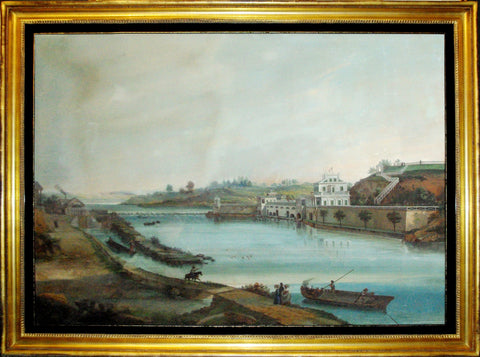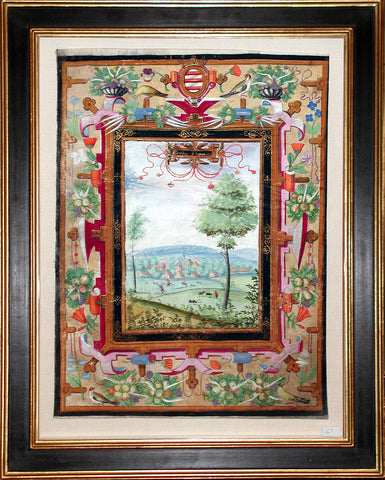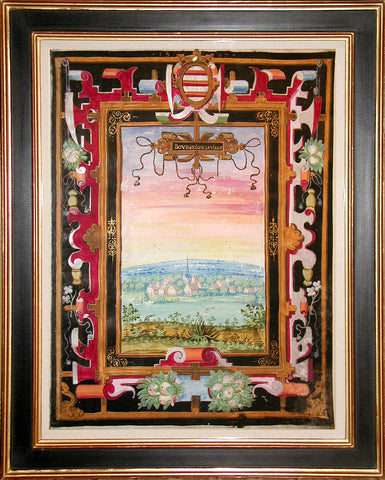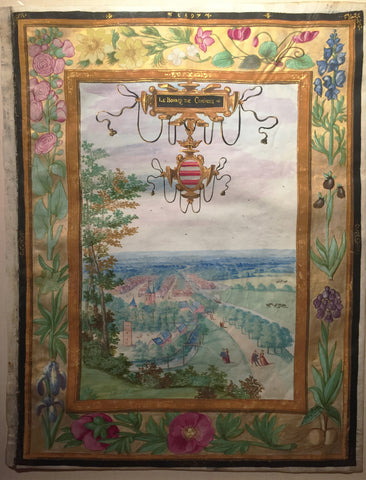
Nicolino Calyo (1799-1884), The Philadelphia Water Works
Nicolino Calyo (1799-1884)
The Philadelphia Water Works
Gouache on paper
Paper size: 44 1/4 x 59 1/2 inches
Inscribed on the verso (twice): ‘Fairmont’
1836
Exhibited: Philadelphia Museum of Art, Pennsylvania (n.d.);
Reference: Philadelphia Museum of Art, The Fairmount Water Works 1988, p. 29 illus. in color; p. 44 checklist.
Between 1819 and 1822, the city of Philadelphia dammed the Schuylkill River to build the Fairmount Water Works to ensure a clean water supply for the growing town. In the ensuing years the location became a favorite destination among Philadelphians for strolling along the river’s edge. With its charming gardens and classical buildings the Water Works was ideal for admiring the scenery along the river. The facilities, including the buildings, machinery, distribution system, and the surrounding gardens, were largely designed by the engineer Frederick C. Graff (1774-1847) and constructed over a period of about forty years beginning in 1812.
Calyo’s view of the Water Works is from approximately the same vantage point as that used by Thomas Birch in his famous 1821 painting, The Fairmount Water Works (The Pennsylvania Academy of the Fine Arts, Philadelphia, bequest of the Charles Graff Estate). Like Birch before him, Calyo chose the prospect afforded by the western approach to the to the Upper Ferry Bridge, which crossed the Schuylkill several hundred feet downstream of the reservoirs, falls, and the pump house. From west to east the panorama encompasses: the lock keeper’s house and the canal of the Schuylkill Navigation Company, the low dam across the river, the white gazebo erected in 1835, and the Neo-classical complex of the engine and mill houses and outbuildings designed by Frederick Graff.
Calyo’s career reflects a restless spirit of enterprise and adventure. Descended from the line of the Viscontes di Calyo of Calabria, the artist was the son of a Neapolitan army officer. He received his formal training in art at the Naples Academy, and his career took shape amidst the political turbulence of early-19th century Italy, Spain, and France. He fled Naples after choosing the loosing side of struggles of 1820-21, and by 1829 was part of an Italian exile community in Malta. This was the keynote of a peripatetic life that saw the artist travel through Europe, to America, within America, perhaps to Europe again, and back to America.
Calyo’s forte was close observation of people and places, meticulously rendered in the precise topographical tradition of his fellow countrymen, Canaletto and Francesco Guardi. In search of artistic opportunity, Calyo left Malta and, by 1834, was on the opposite side of the Atlantic Ocean in Baltimore, Maryland. He rapidly drew attention for his artistically rendered visual images of familiar locales, executed with a degree of polish and skill that was second nature for artists trained in the European academic tradition. Calyo arrived and settled in New York in 1835, inspired by the sights of the flourishing metropolis.
The Philadelphia Water Works
Gouache on paper
Paper size: 44 1/4 x 59 1/2 inches
Inscribed on the verso (twice): ‘Fairmont’
1836
Exhibited: Philadelphia Museum of Art, Pennsylvania (n.d.);
Reference: Philadelphia Museum of Art, The Fairmount Water Works 1988, p. 29 illus. in color; p. 44 checklist.
Between 1819 and 1822, the city of Philadelphia dammed the Schuylkill River to build the Fairmount Water Works to ensure a clean water supply for the growing town. In the ensuing years the location became a favorite destination among Philadelphians for strolling along the river’s edge. With its charming gardens and classical buildings the Water Works was ideal for admiring the scenery along the river. The facilities, including the buildings, machinery, distribution system, and the surrounding gardens, were largely designed by the engineer Frederick C. Graff (1774-1847) and constructed over a period of about forty years beginning in 1812.
Calyo’s view of the Water Works is from approximately the same vantage point as that used by Thomas Birch in his famous 1821 painting, The Fairmount Water Works (The Pennsylvania Academy of the Fine Arts, Philadelphia, bequest of the Charles Graff Estate). Like Birch before him, Calyo chose the prospect afforded by the western approach to the to the Upper Ferry Bridge, which crossed the Schuylkill several hundred feet downstream of the reservoirs, falls, and the pump house. From west to east the panorama encompasses: the lock keeper’s house and the canal of the Schuylkill Navigation Company, the low dam across the river, the white gazebo erected in 1835, and the Neo-classical complex of the engine and mill houses and outbuildings designed by Frederick Graff.
Calyo’s career reflects a restless spirit of enterprise and adventure. Descended from the line of the Viscontes di Calyo of Calabria, the artist was the son of a Neapolitan army officer. He received his formal training in art at the Naples Academy, and his career took shape amidst the political turbulence of early-19th century Italy, Spain, and France. He fled Naples after choosing the loosing side of struggles of 1820-21, and by 1829 was part of an Italian exile community in Malta. This was the keynote of a peripatetic life that saw the artist travel through Europe, to America, within America, perhaps to Europe again, and back to America.
Calyo’s forte was close observation of people and places, meticulously rendered in the precise topographical tradition of his fellow countrymen, Canaletto and Francesco Guardi. In search of artistic opportunity, Calyo left Malta and, by 1834, was on the opposite side of the Atlantic Ocean in Baltimore, Maryland. He rapidly drew attention for his artistically rendered visual images of familiar locales, executed with a degree of polish and skill that was second nature for artists trained in the European academic tradition. Calyo arrived and settled in New York in 1835, inspired by the sights of the flourishing metropolis.
We Also Recommend





